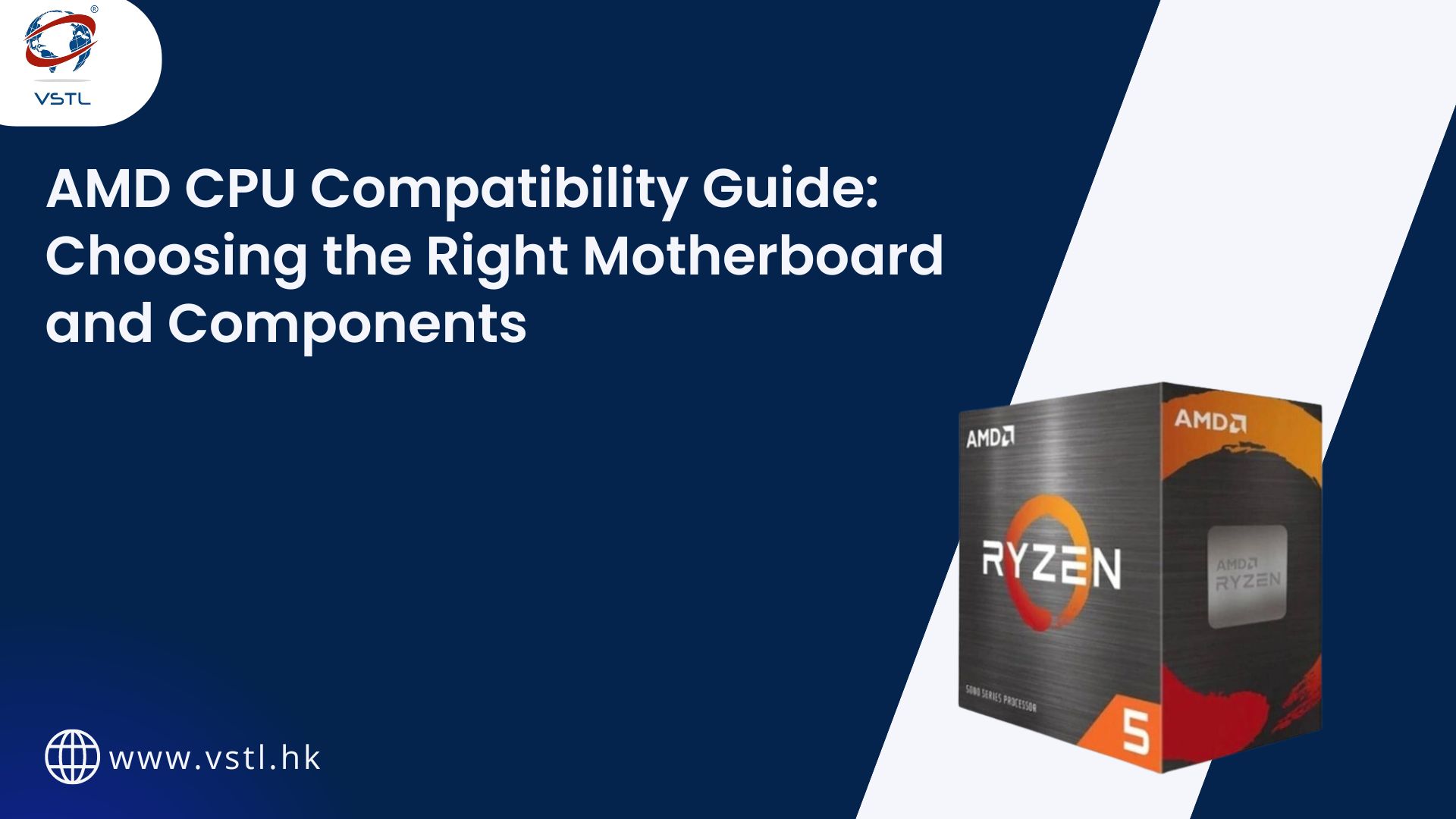
Building a PC with an AMD CPU offers a lot of power and flexibility, but getting the right components is crucial to ensure everything works smoothly together. Whether you’re a seasoned builder or just starting, understanding how to choose the right motherboard and components for your AMD CPU can make a big difference in performance and stability. In this guide, we’ll walk you through everything you need to know to make the best choices.
1. Understanding AMD CPU Sockets
The first step in choosing the right motherboard is understanding AMD CPU sockets. A CPU socket is the interface between the processor and the motherboard. For AMD CPUs, the most common sockets you’ll encounter are:
- AM4: Used by Ryzen series CPUs (including Ryzen 3, 5, 7, and 9). It’s the most versatile and widely used socket, supporting multiple generations of Ryzen processors.
- sTRX4: Designed for AMD’s high-end Threadripper CPUs, intended for professional and enthusiast users who need extreme multitasking and performance.
- SP3: Typically used in servers with AMD EPYC processors. These are not common in consumer-grade builds but are crucial for enterprise solutions.
For most consumer builds, you’ll be dealing with the AM4 socket. This socket is highly compatible and supports a wide range of CPUs, from entry-level to high-end options. Always ensure that the motherboard socket matches the CPU you plan to use.
2. Choosing the Right Chipset
Once you’ve identified the correct socket, the next step is selecting a compatible chipset. A chipset determines the motherboard’s capabilities, including overclocking support, connectivity options, and expansion possibilities. Here’s a breakdown of AMD’s common chipsets:
- A320: Entry-level chipset with basic features, ideal for budget builds that don’t require overclocking or high-speed connectivity.
- B450 and B550: Mid-range chipsets that offer a balance of performance and features, including support for overclocking and PCIe 3.0 or 4.0, depending on the specific chipset.
- X470 and X570: High-end chipsets designed for enthusiasts. They offer advanced overclocking features, more USB ports, and support for PCIe 4.0 on the X570.
- TRX40: Exclusive to Threadripper CPUs, providing extreme performance with support for multiple GPUs, advanced storage options, and extensive overclocking capabilities.
When choosing a chipset, consider what features you need. If you’re building a gaming PC or a workstation with moderate overclocking, the B450 or B550 will be more than sufficient. For high-performance builds, especially those requiring multiple GPUs or extensive overclocking, the X570 or TRX40 chipsets are the way to go.
3. Matching RAM and Motherboard
RAM compatibility is another critical factor when building your AMD system. Here’s what you need to keep in mind:
- Memory Speed and Overclocking: AMD Ryzen CPUs benefit significantly from faster RAM speeds. Most Ryzen CPUs support up to 3200 MHz natively, but many motherboards can handle RAM speeds up to 4000 MHz or higher through overclocking.
- Dual vs. Quad Channel: Most consumer-grade Ryzen builds use dual-channel memory, which provides a good balance between performance and cost. High-end Threadripper builds can utilize quad-channel memory, which offers more bandwidth but requires compatible motherboards and more RAM sticks.
- Capacity: For general use and gaming, 16GB of RAM is a good starting point. For heavy multitasking, video editing, or 3D rendering, consider 32GB or more.
Ensure the RAM you choose is on the motherboard’s Qualified Vendor List (QVL). This list shows RAM modules tested and confirmed to work well with your motherboard, helping avoid compatibility issues.
4. Power Supply Unit (PSU) Considerations
The power supply unit (PSU) is often overlooked but plays a critical role in system stability and longevity. When choosing a PSU for your AMD build, keep these points in mind:
- Wattage: Calculate the total power consumption of your system components using an online PSU calculator. For most Ryzen builds, a 500W to 650W PSU will suffice. For high-end builds with multiple GPUs or Threadripper CPUs, 750W or higher might be necessary.
- Efficiency Rating: Look for an 80 PLUS certified PSU, which guarantees higher efficiency and reliability. Ratings like 80 PLUS Bronze, Silver, Gold, Platinum, and Titanium indicate increasing levels of efficiency.
- Modularity: Modular PSUs allow you to connect only the cables you need, reducing clutter and improving airflow inside your case.
Choosing a high-quality PSU from a reputable brand ensures that your components receive stable and clean power, reducing the risk of damage over time.
5. Storage Options: SSDs and HDDs
Your storage choices can greatly affect your system’s performance. Modern motherboards support a variety of storage options, and here’s what to consider:
- SATA SSDs: These offer great performance for everyday use and are much faster than traditional HDDs. They connect via SATA ports on your motherboard.
- NVMe SSDs: These drives connect directly to your motherboard through M.2 slots and offer significantly faster read and write speeds compared to SATA SSDs. They’re ideal for gaming, content creation, and any task that benefits from high-speed data transfer.
- HDDs: Traditional hard drives are slower but offer large capacities at lower costs, making them suitable for bulk storage.
For the best performance, use an NVMe SSD as your primary drive (for OS and frequently used applications) and a larger HDD for additional storage needs.
6. Cooling Solutions: Keeping Your AMD CPU Cool
AMD CPUs, especially when overclocked, can generate a lot of heat. Choosing the right cooling solution is crucial to maintaining optimal performance and longevity:
- Air Coolers: These are affordable, easy to install, and sufficient for most builds. Look for coolers with larger heatsinks and multiple heat pipes for better heat dissipation.
- Liquid Coolers (AIO): These provide superior cooling performance, especially for overclocked CPUs. They are ideal for high-end builds or when using CPUs like the Ryzen 9 or Threadripper series.
- Custom Water Cooling: For extreme enthusiasts, custom water-cooling loops offer the best cooling performance but are complex and require regular maintenance.
Ensure your chosen cooler is compatible with your CPU socket and fits within your case dimensions.
7. GPU Compatibility
While AMD CPUs are compatible with both AMD and NVIDIA GPUs, matching a GPU to your build depends on your specific needs:
- Gaming: Pairing a mid to high-end Ryzen CPU with a powerful GPU like the NVIDIA RTX 3060 or AMD RX 6700 XT provides excellent gaming performance at 1080p and 1440p resolutions.
- Content Creation: For tasks like video editing or 3D rendering, consider GPUs with more VRAM, like the NVIDIA RTX 3080 or AMD RX 6900 XT.
- Multiple GPUs: If your motherboard and PSU support it, you can run multiple GPUs for increased performance in professional workloads. Ensure your motherboard has enough PCIe slots and your case has sufficient space.
Remember, the GPU and CPU should complement each other to avoid bottlenecks and maximize performance.
8. BIOS Updates and Compatibility
Motherboards are not always updated out of the box to support the latest AMD CPUs. Checking and updating the BIOS is crucial:
- Check BIOS Version: Before purchasing, check if the motherboard supports your CPU’s generation with its current BIOS version. Some older motherboards may require a BIOS update to work with newer Ryzen CPUs.
- Updating BIOS: If needed, update the BIOS by downloading the latest version from the motherboard manufacturer’s website. This process usually involves using a USB drive and following specific instructions provided by the manufacturer.
Keeping your BIOS updated ensures better stability, improved performance, and compatibility with the latest components.
9. Expansion Slots and Future-Proofing
When choosing a motherboard, consider the expansion options for future upgrades:
- PCIe Slots: More PCIe slots allow for additional components like sound cards, network cards, or extra GPUs. Ensure there are enough slots and that they are appropriately spaced to avoid crowding.
- USB Ports and Headers: Consider the number of USB ports (including USB 3.2 or USB-C) that you’ll need for peripherals and devices.
- M.2 and SATA Ports: Check the number of available M.2 slots for SSDs and SATA ports for other storage devices.
Selecting a motherboard with ample expansion options allows you to upgrade your system without needing to replace the entire board.
10. Form Factor Considerations
Motherboards come in various sizes, so ensure the one you choose fits your case:
- ATX: Full-size boards with the most slots and ports. Ideal for mid-tower or full-tower cases.
- Micro-ATX: Smaller than ATX but still offers good expansion options. Fits in smaller cases.
- Mini-ITX: Compact boards with limited slots but perfect for small form factor builds.
Make sure your case supports the motherboard form factor, and consider airflow and cable management when planning your build.
Conclusion
Choosing the right motherboard and components for your AMD CPU is crucial for building a reliable and powerful system. By understanding the compatibility between your CPU, motherboard, RAM, and other components, you can ensure a smooth and efficient build process. Whether you’re gaming, creating content, or running complex applications, the right choices will set the foundation for a system that meets your needs now and in the future. Happy building!
Similar Blogs
1.) The Evolution of Ryzen: From First-Gen to the Latest Releases – Click Here
2.) Intel vs AMD: A Deep Dive into the Ongoing Processor Battle- Click Here
